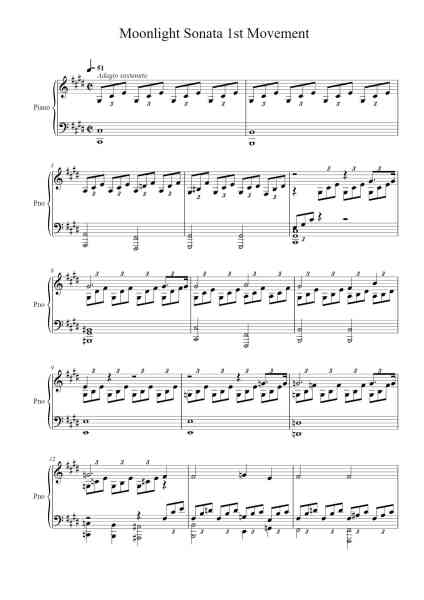
Piano Sonata No. 14 in C-Sharp Minor, Op. 27 No. 2 "Moonlight": I. Adagio sostenuto
Ludwig van Beethoven
15.6K 浏览

Piano Sonata No. 14 in C-sharp Minor, Op. 27 No. 2 "Moonlight": III. Presto agitato
Ludwig van Beethoven
1.8K 浏览

Piano Sonata No. 14 in C-Sharp Minor, Op. 27, No. 2 "Moonlight": I. Adagio sostenuto
Ludwig van Beethoven
1.7K 浏览

Piano Sonata No. 14 in C-Sharp Minor, Op. 27, No. 2 "Moonlight": I. Adagio sostenuto "EASY version"
Ludwig van Beethoven
1.6K 浏览

Piano Sonata No. 14 in C-sharp Minor, Op. 27, No. 2: I. Adagio sostenuto "Moonlight"
Ludwig van Beethoven
1.5K 浏览

Piano Sonata No. 14 in C-Sharp Minor, Op. 27 No. 2 "Moonlight": III. Presto agitato
Ludwig van Beethoven
1.3K 浏览

Piano Sonata No. 14 in C-Sharp Minor "Moonlight", Op. 27, No. 2: I. Adagio sostenuto
Ludwig van Beethoven
890 浏览

Piano Sonata No. 14 in C-Sharp Minor, Op. 27 No. 2 "Moonlight": III. Presto agitato
Ludwig van Beethoven
861 浏览

Piano Sonata No. 14 in C-sharp Minor, Op. 27, No. 2 "Moonlight": III. Presto agitato
Ludwig van Beethoven
776 浏览

Piano Sonata No. 14 in C-Sharp Minor, Op. 27, No. 2 "Moonlight": III. Presto agitato
Ludwig van Beethoven
650 浏览

Piano Sonata No. 14 in C-Sharp Minor, Op. 27 No. 2 "Moonlight": I. Adagio sostenuto
Ludwig van Beethoven
567 浏览

Piano Sonata No. 14 in C-sharp Minor, Op. 27, No. 2: I. Adagio sostenuto "Moonlight"
Ludwig van Beethoven
560 浏览

Piano Sonata No. 14 in C-Sharp Minor, Op. 27, No. 2 "Moonlight": II. Allegretto
Ludwig van Beethoven
549 浏览

Piano Sonata No. 14 in C-sharp Minor, Op. 27, No. 2 "Moonlight Sonata": III. Presto agitato
Ludwig van Beethoven
533 浏览
Roblox Sheet

Roblox Sheet
Piano Sonata No. 14 in C-Sharp Minor, Op. 27, No. 2 "Moonlight": I. Adagio sostenuto
Ludwig van Beethoven
以全新方式体验 Piano Sonata No. 14 in C-Sharp Minor, Op. 27, No. 2 "Moonlight": I. Adagio sostenuto 由 Ludwig van Beethoven 演绎!使用您的键盘演奏 Piano Sonata No. 14 in C-Sharp Minor, Op. 27, No. 2 "Moonlight": I. Adagio sostenuto Roblox 钢琴谱。无论您是 Roblox 钢琴游戏玩家,还是想练习经典作品,这个 Piano Sonata No. 14 in C-Sharp Minor, Op. 27, No. 2 "Moonlight": I. Adagio sostenuto Roblox 钢琴谱都非常适合您,帮助您从初学者轻松进阶到专家。Piano Sonata No. 14 in C-Sharp Minor, Op. 27, No. 2 "Moonlight": I. Adagio sostenuto 位于 TOP 100 Roblox 钢琴谱之列,还有许多其他简单、经典、流行、圣诞歌曲和迪士尼歌单等您来演奏!
35 浏览





